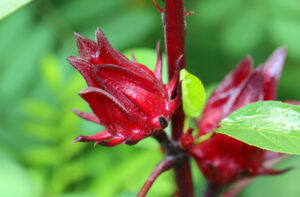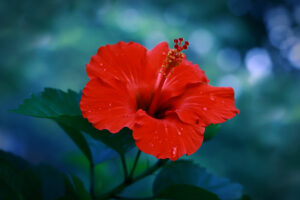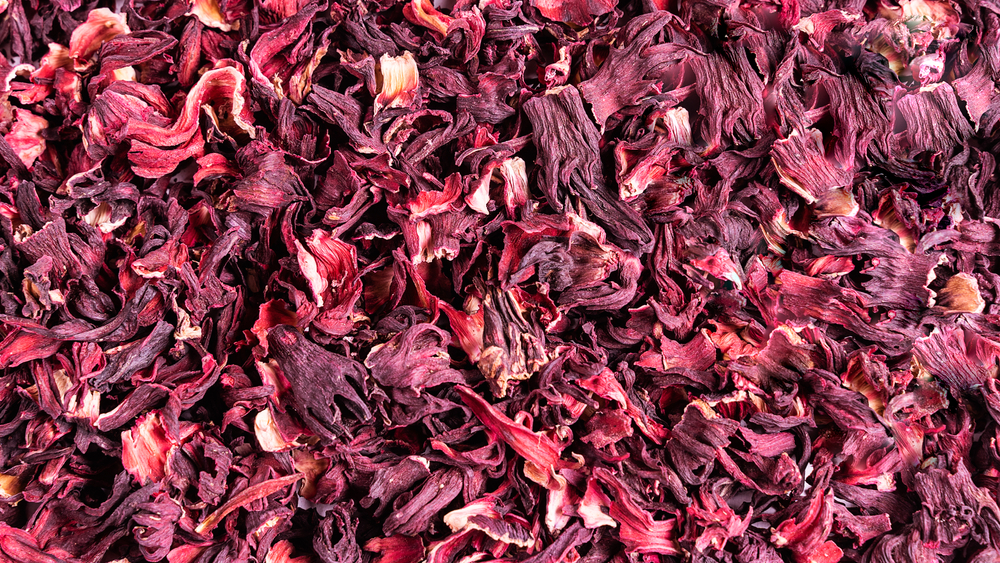Hibiscus Flowerr (Dried)
The hibiscus flower is a vibrant, showy bloom that belongs to the family Malvaceae. It is characterized by its trumpet-like shape, prominent stamens, and bright colors, often ranging from red and pink to yellow and white. Hibiscus flowers are widely recognized for their ornamental beauty and diverse uses in various cultures.
Uniqueness of Hibiscus Sabdariffa:
Hibiscus sabdariffa, also known as Roselle, is unique for its deep red calyxes that are used in culinary and medicinal applications. These calyxes are rich in antioxidants and lend a tart flavor, making them suitable for beverages, jams, and more.
Difference Between Hibiscus Sabdariffa vs. Rosa Sinensis:


Hibiscus Sabdariffa
-
Usage: Calyxes are consumed for teas, culinary, and medicinal purposes.
-
Flavor: Offers a tangy taste with potential health benefits.
-
Health Benefits: Associated with various potential health advantages.
-
Edibility: Calyxes are edible and utilized in different dishes.
-
Culinary Use: Used in teas, jams, sauces, and more.
-
Herbal Applications: Employed in herbal medicine for diverse remedies.
-
Calyx Shape: Calyxes are larger and deeper, forming the edible part.
-
Cultural Significance: Culturally important in multiple regions.
-
Nutritional Content: Contains antioxidants, vitamins, and nutrients.
-
Commercial Uses: Valued for culinary, medicinal, and commercial purposes.
Hibiscus Rosa-Sinensis
-
Usage: Primarily ornamental, not consumed in food or beverages.
-
Flavor: Lacks a distinct flavor suitable for consumption.
-
Health Benefits: Generally not linked to potential health benefits.
-
Edibility: Flowers are not typically consumed due to their ornamental nature.
-
Culinary Use: Not used in culinary applications.
-
Herbal Applications: Not commonly used in herbal remedies.
-
Petal Shape: Features decorative petals, not used as an edible part.
-
Cultural Significance: Holds cultural significance with varied meanings.
-
Nutritional Content: Typically lacks significant nutritional content.
-
Commercial Uses: Primarily used for landscaping and ornamental purposes.
Top Health Benefits
Top 20 Health Benefits of Hibiscus Sabdariffa
-
Antioxidant-rich: Hibiscus is abundant in antioxidants like flavonoids and anthocyanins, which combat free radicals and oxidative stress, potentially reducing the risk of chronic diseases.
-
Supports Heart Health: Hibiscus may aid heart health by assisting in maintaining healthy blood pressure levels and supporting the management of cholesterol levels, promoting overall cardiovascular well-being.
-
Digestive Aid: The soothing properties of hibiscus tea can alleviate digestive discomfort, bloating, and indigestion, facilitating smoother digestion and promoting gut health.
-
Immune Boost: Packed with vitamin C, hibiscus helps strengthen the immune system, enhancing the body's defense mechanisms against infections and illnesses.
-
Weight Management: Hibiscus tea's metabolism-boosting effects may aid in weight management by promoting efficient calorie burning and supporting weight loss goals.
-
Anti-Inflammatory: The anti-inflammatory compounds in hibiscus can reduce inflammation and provide relief from conditions such as arthritis and other inflammatory disorders.
-
Blood Sugar Control: Hibiscus may help manage blood sugar levels by inhibiting the absorption of carbohydrates and assisting insulin regulation, potentially beneficial for those with diabetes.
-
Rich in Vitamin C: With a significant vitamin C content, hibiscus supports immune function, collagen synthesis for skin health, and contributes to overall vitality.
-
Kidney Health: Hibiscus has been associated with promoting kidney health, as it may help prevent the formation of kidney stones and support optimal renal function.
-
Menstrual Relief: The antispasmodic properties of hibiscus can ease menstrual cramps and discomfort, providing relief during the menstrual cycle.
-
Liver Health: Hibiscus may support liver function and detoxification processes, aiding in the elimination of toxins from the body.
-
Antibacterial Properties: Certain compounds in hibiscus possess antibacterial properties that can help combat bacterial infections and contribute to maintaining overall health.
-
Antiviral Potential: Hibiscus may possess antiviral properties, potentially assisting in fighting certain viruses and supporting the immune system's response to infections.
-
Antidepressant Effects: Hibiscus contains natural compounds that can promote relaxation and help alleviate stress and anxiety, contributing to overall mental well-being.
-
Hair Growth: The nutrients in hibiscus nourish hair follicles and stimulate circulation in the scalp, which can promote healthy hair growth and reduce hair loss.
-
Skin Hydration: Hibiscus supports skin hydration by improving moisture retention, contributing to a smoother, plumper complexion.
-
Acne Treatment: Hibiscus's natural AHA (alpha hydroxy acid) content helps control excess oil production, unclog pores, and soothe inflammation, making it beneficial for managing acne-prone skin.
-
Wound Healing: Hibiscus's anti-inflammatory and antioxidant properties contribute to faster wound healing by reducing inflammation and promoting tissue regeneration.
-
Anti-Aging: Rich in antioxidants, hibiscus protects the skin from free radical damage, helping to prevent premature aging and maintaining youthful skin.
-
Allergy Relief: Hibiscus's anti-inflammatory properties may alleviate allergy symptoms, providing relief from nasal congestion, sneezing, and inflammation associated with allergies.
Top Hair Benefits of Hibiscus Sabdariffa
-
Hair Growth: Hibiscus's natural properties stimulate hair follicles by increasing blood circulation to the scalp. This can lead to improved hair growth and thicker, healthier locks.
-
Scalp Health: Hibiscus soothes a dry, itchy scalp due to its moisturizing and calming properties. It can also alleviate dandruff by reducing flakiness and irritation.
-
Strengthens Hair: The nutrients in hibiscus nourish hair strands, making them stronger and more resilient. This can lead to reduced breakage and healthier overall hair.
-
Adds Shine: Hibiscus enhances hair's natural shine and luster by smoothing the hair cuticles, resulting in glossy and vibrant-looking locks.
-
Reduces Hair Loss: By promoting hair follicle health and strengthening hair, hibiscus can help reduce hair fall and minimize breakage, leading to fuller-looking hair.
Top Skin Benefits of Hibiscus Sabdariffa
-
Skin Soothing: Hibiscus's anti-inflammatory properties help calm irritated skin and reduce redness. It's particularly beneficial for sensitive or reactive skin types.
-
Acne Control: Hibiscus balances oil production in the skin, making it an effective natural remedy for acne. It also contains natural alpha hydroxy acids (AHAs) that exfoliate and unclog pores.
-
Antioxidant Boost: The antioxidants in hibiscus protect the skin from environmental damage caused by factors like pollution and UV rays, helping to maintain youthful skin.
-
Hydration Support: Hibiscus's natural mucilage content helps retain moisture in the skin, preventing dryness and promoting a healthy, hydrated complexion.
-
Anti-Aging: With its antioxidants and AHAs, hibiscus can help reduce the appearance of fine lines, wrinkles, and other signs of aging, promoting a smoother and more youthful complexion.
Special Features of Hibiscus Flower:
Hibiscus flowers are prized for their vibrant colors, unique floral structures, and diverse applications in beverages, culinary creations, herbal remedies, and skincare.
Interesting Facts about Hibiscus:
- Hibiscus flowers come in over 200 species, with varying colors and sizes.
- Many cultures use hibiscus as a symbol of beauty and femininity.
- Hibiscus tea is known as "sour tea" in some countries due to its tangy flavor.
Hibiscus Sabdariffa Recipes for Various Beverages and Culinary Creations:
1. Hibiscus Tea:
- Boil water and add dried hibiscus petals.
- Steep for 5-10 minutes, then strain.
- Sweeten with honey or lemon if desired.
2. Hibiscus Iced Tea:
- Prepare hibiscus tea as above.
- Chill and serve over ice with a slice of orange.
3. Hibiscus Lemonade:
- Mix hibiscus tea with fresh lemon juice and sweetener.
- Add water and ice for a refreshing drink.
4. Hibiscus Mojito Mocktail:
- Blend hibiscus tea with mint leaves, lime juice, and soda water.
5. Hibiscus Smoothie:
- Blend hibiscus tea with frozen berries, banana, and yogurt for a nutritious smoothie.
6. Hibiscus Infused Water:
- Add dried hibiscus petals to a jug of water and refrigerate for a naturally flavored hydrating drink.
7. Hibiscus Jam:
- Cook hibiscus petals with sugar and lemon juice until thickened. Use as a spread for toast or pastries.
8. Hibiscus Jelly:
- Strain hibiscus infusion and cook with pectin and sugar for a vibrant jelly.
9. Hibiscus Syrup:
- Make a hibiscus-infused simple syrup to sweeten beverages or drizzle over desserts.
10. Hibiscus Sorbet:
- Blend hibiscus tea with sugar and freeze for a refreshing sorbet.
11. Hibiscus Juice:
- Blend hibiscus petals with water, strain, and sweeten for a homemade juice.
12. Hibiscus Iced Latte:
- Mix hibiscus tea with milk or a milk alternative for a creamy iced latte.
13. Hibiscus Margarita Mocktail:
- Combine hibiscus tea with lime juice and agave syrup for a non-alcoholic margarita twist.
14. Hibiscus Punch:
- Mix hibiscus tea with fruit juices, soda, and fresh fruit slices for a vibrant punch.
15. Hibiscus Sparkling Lemonade:
- Blend hibiscus tea with sparkling water and fresh lemon juice for a fizzy lemonade.
16. Hibiscus Sangria:
- Mix hibiscus tea with red or white grape juice, diced fruit, and a splash of orange liqueur.
17. Hibiscus Infused Vodka:
- Steep dried hibiscus petals in vodka for a unique infusion to use in cocktails.
18. Hibiscus Chia Fresca:
- Combine hibiscus tea with chia seeds and sweetener for a hydrating chia fresca.
19. Hibiscus Kombucha:
- Use hibiscus tea as a base for brewing homemade kombucha with added probiotic benefits.
20. Hibiscus Infused Olive Oil:
- Infuse olive oil with dried hibiscus petals for a unique flavor to use in dressings or dips.
These creative recipes allow you to enjoy the health benefits of hibiscus sabdariffa in various delicious forms. Remember to adjust ingredients and proportions based on your preferences.

